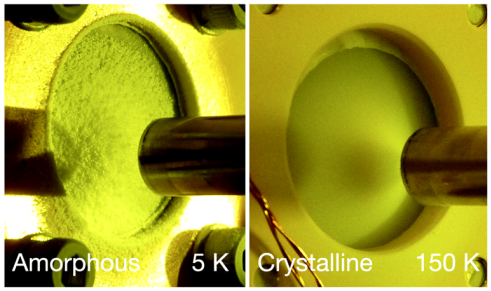Discovery & History#
of Amorphous Ice
Introduction
Notes
To Do
Think about coherent plan
Implement
Colaboration
Star formation is not my expertise so if you want to help, feel free to comment the contribution you could make
Discovery#
Amorphous solid water, is a form of ice that lacks a crystalline structure. It is also referred to as non-crystalline, glassy, or vitreous ice. Unlike crystalline ice, which has a well-defined periodic arrangement of molecules, ASW is disordered and lacks long-range order (similar to glass)
The first experimental description of amorphous water ice has been achieved in 1935 by [] that deposited water vapor on a copper rod maintained at -155 ℃ It has since been an intense subject of research involving multiple production method and characterisation techniques.
» Amorphous Solids #
Amorphous ice does not naturally form under Earth conditions (Pressure and Temperature)
That is why you may not be familliar with it, however there is a whole diversity of amorphous materials that you may encounter in your everyday life:
» Amorphous vs Crystaline ice #
Note
insert 2 MD structure to show the differences
We have seen crystaline ice in previous chapter (link)
Long range order …
Amorphous ice is …

Fig. 9 Source- Arxiv - to extract and put in bib#
» Supercooled liquid and Glasses #
» Water Polyamorphism #
Note
Definition
Note
- Jenniskens
- []
- []
To read and extract why those papers are controversial.
How many Amorphous Ices is there ?#
- [] 5 main categories of Amorphous ice
- []: High-density ASW annealing, neutron & X-ray diffraction, 5 distinct ASW forms – all metastable at each anneal T, structure evolves systematically between 4 – 8 K.
Characterised by their mass densities, respectively 0.92, 1.15 and 1.25 g.cm-2
Other forms#
- IDA: Intermediate Density Amorphous
- Can’t be considered a polyamorph because can’t be equilibrated
- MDA: Medium Density Amorphous
High Density vs Low density #
Note
How do they differ
- OO distances …
Radial distribution function …
Medium Density ? #
Amorphous Solid Water#
Note
- different experimental conditions different forms of ice …
ASW vs Ih vs Clathrate#
- Review: []
Investigation techniques#
Experimental#
Note
- Create html tables with all ASW experiments.
- 1 table for all experiments
- 1 entry per scientific group
Unclassified yet: []
Warning
table was ther but got suppressed, to check
Calorimetric studies#
TPD (Temperature Program Desorption) / DSC (Differential Scanning Calorimetry)
Warning
table was ther but got suppressed, to check
Infrared Spectroscopy#
Absorption / Reflection
Water alone or in mixture
 Onion layers
Onion layers
Warning
table was ther but got suppressed, to check
Optical constants - necessary to produce “artificial” spectra necessary to fit observation. Experimental spectra can also be directly feated to observation cf Alexis work.
Scattering Experiments#
XRay/ Neutron
Best technique to obtain information on crystal structure. Costly and lots of other constraints.
Simulations#
Molecular Dynamics#
- [Essmann and Geiger, 1995]: Molecular dynamics simulation, vapour deposited ASW, compared to neutron scattering data from high & low density ASW (pressure induced transformation of crystalline ice), result: vapour deposited ASW between the other two, but closer to high density ASW, agreement with vapour deposited ASW neutron scattering & electron diffraction studies, ASW surface layer deeply fissured (-> high porosity of vapour deposited ice).
» Investigation techniques #
Scattering #
X-RAY#
[]
Neutron#
- Incoherent inelastic neutron scattering []: Neutron scattering of HDA (from pressure0induced amorphisation), LDA (from annealing HDA, hyperquenched liquid water, Ih, & Ic, H-bond interaction in LDA differ from hyperquenched water & are stronger than in HDA.
Spectroscopy #
More#
- positron and positronium annihilation []
Production method#
[] - Matrix sublimation method for the formation of high density amorphous ice
- Why ?
- …
Questions
- difference between vitreous material and amorphous solid ?
- Glassy vs vitreous ?
[Narten et al., 1976] showed that different deposition temperatures using the same vapor deposition setup and methodology would lead to two different forms of amorphous ice, where those differences are inferred from diffraction data (both Neutron and X-Ray):
Ice deposited at 77K is low density
Diffraction pattern consistent with a structure that has oxygen-oxygen nearest-neighbor tetrahedral symmetry on average, and a nearest neighbor 0-0 separation of 2.76 Å with small dispersion; -> What is meant by this ?
Density estimated 0.94 g.cm-3
Ice deposited at 10K is high density
Diffraction pattern similar to, yet distinctively different from, that of the high temperature deposit. The 0-0 nearest neighbor distance is the same. 2.76 Å but the dispersion in this separation is larger in the low temperature form.
Diffraction pattern shows an extra peak at 3.3 Å. corresponding to about 1.4 molecules. the existence of which is responsible for the estimated higher density, namely 1.1 g.cm-3
Question
How is the density determined from Diffraction data
When subject to increasing pressure, amorphous ice soften (what is meant by this ?) and then suddenly collapse to a denser but still amorphous phase. This result is verified by computer simulations where density and structure of the high density amorphous form depends on the potential function chosen to represent the water.
- to verify (ref 5 - 7) simulation 8-9
Despite the non-crytalline nature of the molecular arrangements in LDA, both the thermodynamic state and the vibrational characteristics are those of a highly ordered substance. The heat carrying phonons of low temperature amorphous water behave like those in a crystal.
- What does this mean, where does it come from ? Similar (but less dramatic) behaviour have been observed in other tetrahedrally coordinated solid (SiO2, GeO2, ZNCl2 etc).
ASW#
Vapor deposition methods were employed to prepare ASW for the following studies:
- Calorimetry
- Spectroscopy
- vapor pressure and free energy
- Crystalisation 33,35,34,36
- [Jenniskens and Blake, 1996]
- [] - Thickness dependance, Investigated by TPD
- model : 78 - 79
- Dielectric relaxation
- Neutron and X-ray diffraction structure studies
- diffusion studies
- electron microscope
- vibrational dynamics studies (by neutron scattering)
- Thermal conductivity studies
The sharp crystallization exotherm commencing in the range of 150–160 K during reheating is the one universal feature of all previous studies of ASW or vitreous water.
Other preparation techniques#
- cold microtoming method (68)
- decompression amorphization (73)
- electron bombardment vitrification (67, 76, 76a) - could be compatible with accoustic levitation
- radiation damage–induced vitrification (77)
- phase-separation vitrification (12)
- plunge freeze (67)
Note
strong upswing in heat capacity seen in bulk laboratory supercooling water (81)
Heat capacity increase is also a main varying parameter obeserved during glass transition (Tg)
Narten et al. (39)
- random structure of ASW.
- second form of ASW - additional peak at 3.3 ̊Angstrom (interstitial water molecule) - Higher density (observed at 10K)
- First indication of the existence of polyamorphism
do they coexist in metastable equilibrium Mishima 5-7
Structure#
Amorphous vs Crystaline Ice#
How does amorphous ices differs from its crystaline conterpart ? Well it depends on the formation route of the amorphous ice.
Crystaline
- Polymorph: 18 ?
- Ice rules
Amorphous
- Polymorph: 5
- Structure dependant on deposition conditions
Note
- Show 2 samples deposited at different T conditions
- Same T but different thickness
Amorphous ice - supercooled liquid water
Morphology#
- []
Influence of the Substrate#
- [Smith et al., 1996]
- desorption kinetics are substrate dependent and suggest strongly that the film morphology is governed by the hydrophilicity of the substrate.
- crystallization kinetics are independent of substrate but depend strongly on both temperature and film thickness and are consistent with a spatially random nucleation and isotropic growth model.
- []
- dramatic acceleration of the crystallization rate is observed for amorphous films on crystalline ice substrates
- crystallization-induced cracking of the films
To check
- Katrina …
Scientic field of interest#
Material Sciences#
Note
proximity with liquid water
Atmospheric Science#
ASW plays an important role in atmospheric processes, such as cloud formation and ice nucleation. Clouds are formed when water vapor in the atmosphere condenses onto tiny particles, such as dust or pollen, forming droplets. In certain conditions, such as at high altitudes, these droplets can freeze and form ice crystals. The presence of ASW can affect the freezing point of water, which can have significant implications for cloud formation and atmospheric processes.

